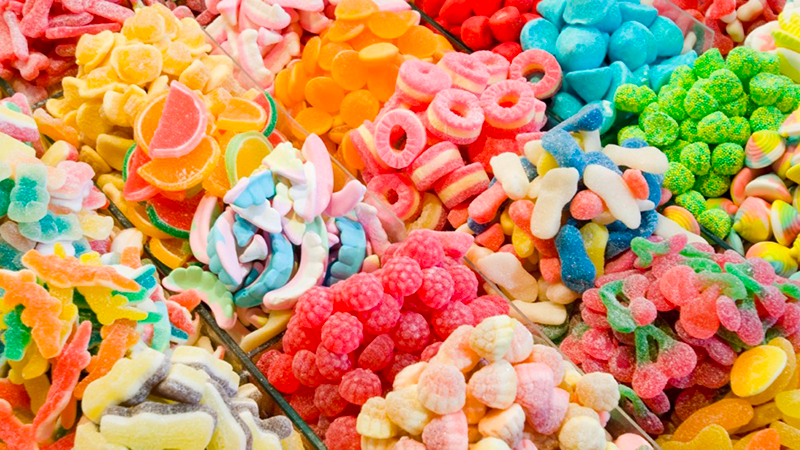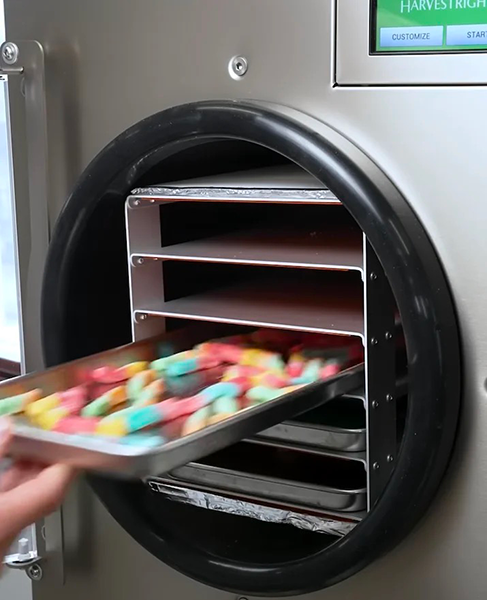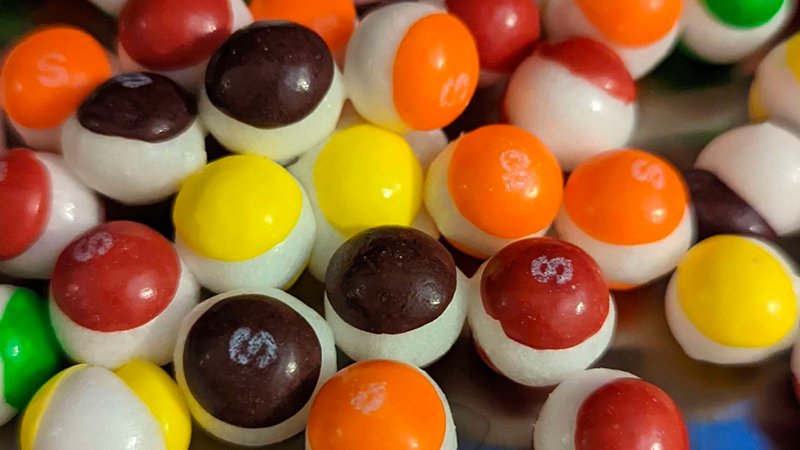
Content Menu
● Understanding Dehydration and Freeze Drying
>> Dehydration Process
>> Freeze-Drying Process
● Can You Use A Food Dehydrator To Freeze Dry Candy?
>> Key Differences Between Dehydration and Freeze Drying
● Step-by-Step Guide: Using a Food Dehydrator to Mimic Freeze Drying Candy
● Benefits of Freeze-Dried Candy
● Limitations of Using a Food Dehydrator for Freeze Drying
● Additional Uses for Food Dehydrators
● Health Benefits of Dehydrated Foods
● Exploring More About Food Dehydrators
>> How Do Food Dehydrators Work?
● Popular Recipes Using Food Dehydrators
● Final Thoughts
● Conclusion
● FAQ
>> 1. What types of candy work best for freeze drying in a dehydrator?
>> 2. How long does it take to freeze dry candy in a dehydrator?
>> 3. Can I use chocolate or caramel candies in my dehydrator?
>> 4. How should I store my freeze-dried candy?
>> 5. Is there any difference in taste between dehydrated and freeze-dried candy?
● Citations:
Food dehydrators have gained popularity among home cooks and food enthusiasts for their ability to preserve food by removing moisture. However, a question often arises: Can you use a food dehydrator to freeze dry candy?This article will explore the differences between dehydration and freeze-drying, provide a step-by-step guide for using a dehydrator to mimic freeze-drying, and discuss the benefits of each method.

Understanding Dehydration and Freeze Drying
Dehydration Process
Dehydration is a method that removes moisture from food using low heat and airflow. Food dehydrators typically operate at temperatures ranging from 85°F to 160°F (29°C to 71°C). The process involves:
- Heat Application: The dehydrator uses low temperatures to evaporate moisture.
- Air Circulation: Fans circulate air around the food, promoting even drying.
- Preservation: This method helps prevent the growth of bacteria, yeast, and mold, extending the shelf life of foods while retaining most nutrients.
The result is a product that retains some moisture but has a chewy texture, ideal for snacks like dried fruits or jerky.
Freeze-Drying Process
Freeze drying (lyophilization) is a more complex process that involves:
- Freezing: The food is first frozen at extremely low temperatures, often below -40°F (-40°C).
- Vacuum Chamber: The frozen food is placed in a vacuum chamber where the pressure is lowered. This allows ice to transition directly from solid to vapor without passing through a liquid state (sublimation).
- Final Product: The result is a lightweight, crispy product that retains its original flavor and nutritional value, making it perfect for long-term storage.
Can You Use A Food Dehydrator To Freeze Dry Candy?
While food dehydrators are excellent for traditional dehydration, they are not designed for freeze-drying. The lack of a vacuum chamber and the inability to reach extremely low temperatures means that true freeze-drying cannot be achieved with a dehydrator. However, you can partially mimic the freeze-drying process with certain types of candy.
Key Differences Between Dehydration and Freeze Drying
| Feature | Dehydration | Freeze Drying |
| Temperature | 85°F to 160°F (29°C to 71°C) | Below -40°F (-40°C) |
| Process | Heat + Airflow | Freezing + Vacuum |
| Texture | Chewy | Crispy |
| Nutritional Retention | Moderate | High |
| Equipment Required | Dehydrator | Freeze Dryer |
Step-by-Step Guide: Using a Food Dehydrator to Mimic Freeze Drying Candy
If you're interested in experimenting with freeze-drying candy using your dehydrator, follow these steps:
1. Select the Right Candy: Choose candies that are suitable for this process. Hard candies, gummies, and fruit-flavored candies work best. Avoid chocolates or candies with high-fat content as they do not freeze dry well.
2. Prepare the Candy: Remove any wrappers and arrange the candy in a single layer on the dehydrator trays. Ensure there's space between each piece for proper airflow.
3. Set the Temperature: Adjust your dehydrator to its lowest possible setting, ideally around 95°F to 110°F (35°C to 43°C).
4. Start the Dehydrator: Turn on the dehydrator and let it run for an extended period—typically between 24 to 48 hours depending on humidity levels and candy type.
5. Check for Doneness: Periodically check the candy for dryness. It should feel dry and brittle when done. If it bends or feels sticky, it needs more time.
6. Store Properly: Once fully dried, remove the candy from the dehydrator and allow it to cool completely before transferring it to airtight containers to prevent moisture absorption.

Benefits of Freeze-Dried Candy
Freeze-dried candy offers several advantages:
- Long Shelf Life: With moisture removed, these candies can last significantly longer than their regular counterparts.
- Intense Flavor: The freeze-drying process concentrates flavors, resulting in a more robust taste.
- Unique Texture: The crispy texture provides an enjoyable eating experience different from traditional chewy candies.
Limitations of Using a Food Dehydrator for Freeze Drying
While using a food dehydrator can yield interesting results, there are limitations:
- Inconsistent Results: The texture may not fully replicate that of commercially freeze-dried candy.
- Time-Consuming: The process can take much longer than traditional dehydration methods.
- Not True Freeze-Drying: Without vacuum conditions, some moisture may remain in the candy.
Additional Uses for Food Dehydrators
Food dehydrators are versatile tools that can be used for various applications beyond just candy:
- Dried Fruits and Vegetables: Create healthy snacks by drying apples, bananas, strawberries, or vegetables like tomatoes and zucchini.
- Jerky Making: Prepare homemade jerky using lean cuts of meat marinated in your favorite sauces.
- Herbs and Spices: Preserve fresh herbs by drying them for later use in cooking or seasoning.
- Fruit Leather: Blend fruits with sweeteners and dry them into delicious fruit leather snacks.
- Yogurt Making: Some dehydrators allow you to maintain low temperatures suitable for yogurt fermentation.
Health Benefits of Dehydrated Foods
Dehydrating foods not only extends their shelf life but also offers several health benefits:
- Nutrient Retention: Dehydrated foods retain most of their nutritional value compared to cooked foods since they are not subjected to high heat.
- High Fiber Content: Dried fruits and vegetables have concentrated fiber content which aids digestion and promotes gut health.
- Low-Calorie Snacks: Dried fruits can serve as healthier alternatives to sugary snacks while providing energy boosts due to their concentrated sugars.
Exploring More About Food Dehydrators
Food dehydrators are not just limited tools; they represent an entire approach towards healthier eating habits by allowing individuals full control over what goes into their food. By understanding how these machines work and how they can be utilized effectively, users can make informed decisions about their dietary choices while reducing waste significantly.
How Do Food Dehydrators Work?
Food dehydrators operate through several key mechanisms:
1. Airflow Management:
- Most models feature fans that circulate warm air throughout the unit.
- This airflow helps ensure even drying across all trays.
- Proper airflow prevents hotspots which could lead to uneven results or spoilage due to retained moisture.
2. Temperature Control:
- Many modern dehydrators come with adjustable temperature settings.
- Different foods require different drying temperatures; fruits generally need higher heat than herbs.
- Users can select appropriate settings based on what they're drying—this flexibility enhances results significantly.
3. Energy Efficiency:
- Compared with conventional ovens which consume much more energy due to higher wattage requirements.
- Dehydrators operate at lower temperatures over extended periods but use less electricity overall.
- This makes them cost-effective appliances suitable for regular use without exorbitant utility bills.
4. Safety Features:
- Many models come equipped with timers that automatically shut off after designated periods.
- This feature prevents over-drying which can ruin food quality.
- Some units also include built-in safety mechanisms against overheating—ensuring safe operation during prolonged use periods.
Popular Recipes Using Food Dehydrators
Food dehydrators open up endless possibilities when it comes to creating unique snacks or meal components:
- Dried Fruit Snacks
- Simple yet delicious; slice fruits like apples or peaches thinly before placing them on trays.
- Sprinkle lightly with cinnamon or sugar if desired before drying at around 135°F (57°C) until they reach desired chewiness.
- Vegetable Chips
- Slice vegetables such as kale or sweet potatoes thinly.
- Toss them lightly with olive oil and seasonings before drying at around 125°F (52°C).
- Homemade Granola
- Combine oats with nuts/seeds along with honey/maple syrup; spread mixture onto trays evenly.
- Dry at approximately 145°F (63°C) until crispy—great as breakfast or snack!
Final Thoughts
In summary, while utilizing a food dehydrator does not equate directly with achieving true freeze-dried products—especially when it comes down specifically towards candies—the versatility offered by these machines cannot be overstated! From creating nutritious snacks like dried fruits/vegetables through making flavorful jerky options—dehydrators cater towards diverse culinary needs while promoting healthier lifestyles overall!
Conclusion
In conclusion, while you cannot achieve true freeze-drying with a food dehydrator due to its design limitations, you can still create an interesting alternative by following specific steps tailored for certain types of candy. This method offers an opportunity for creative experimentation in the kitchen. Whether you're looking to preserve your favorite treats or simply enjoy unique textures and flavors, using a food dehydrator can be an enjoyable culinary adventure.

FAQ
1. What types of candy work best for freeze drying in a dehydrator?
Hard candies, gummies, marshmallows, and fruit-flavored candies are ideal choices due to their lower moisture content.
2. How long does it take to freeze dry candy in a dehydrator?
The process typically takes between 24 to 48 hours depending on the type of candy and humidity levels.
3. Can I use chocolate or caramel candies in my dehydrator?
It is not recommended as high-fat content candies like chocolate or caramel do not freeze dry well and may result in undesirable textures.
4. How should I store my freeze-dried candy?
Store your freeze-dried candy in airtight containers kept in a cool, dry place to maintain its texture and flavor.
5. Is there any difference in taste between dehydrated and freeze-dried candy?
Yes, freeze-dried candy tends to have a more intense flavor due to moisture removal compared to dehydrated candy which retains some moisture and has a chewier texture.
Citations:
[1] https://www.webstaurantstore.com/guide/741/food-dehydrators-buying-guide.html
[2] https://misterchef.co.uk/how-to-freeze-dry-candy-with-a-dehydrator/
[3] https://www.commercialdehydrators.com.au/dehydrating-recipes-filters
[4] https://www.bestbuy.com/discover-learn/10-reasons-to-buy-a-food-dehydrator/pcmcat1634332391134
[5] https://candyjan.com/blogs/news/can-you-make-freeze-dried-candy-in-a-dehydrator
[6] https://www.youtube.com/watch?v=rXNIHzcE8F0
[7] https://www.webmd.com/diet/dehydrating-food-good-for-you
[8] https://www.reddit.com/r/dehydrating/comments/155t131/how_does_candy_come_out_when_dehydrated/
[9] https://eatsleepwild.com/homemade-dehydrated-backpacking-meals/
[10] https://www.goodhousekeeping.com/appliances/a31904157/what-is-a-dehydrator/











